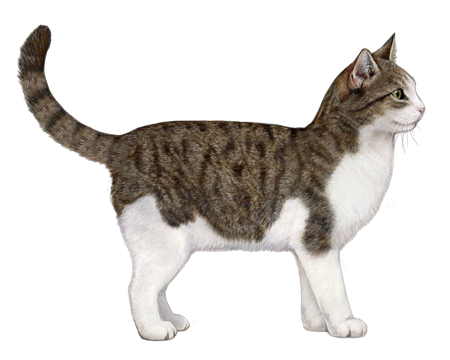
Norwegian Forest Cat
Mild-mannered and patient, Norwegian Forest Cats love being part of a family. They're a relatively low-maintenance breed with a gentle nature and strong nurturing instinct.
Interested in discovering if your cat is a Norwegian Forest Cat?
Check out Wisdom Panel's DNA test.
Norwegian Forest Cat Traits
General Appearance
Norwegian Forest Cats are large cats that can take up to five years to reach their full growth potential. Their bodies are sturdy, well-balanced, and muscular.
Coat and Coloring
A thick double coat comprised of a dense undercoat and long, glossy, water-resistant topcoat is a distinguishing feature of the breed. The hair forms a thick ruff, mutton chops, and full britches.
Norwegian Forest Cats come in most colors and patterns—including white, black, blue, silver, tortoiseshell, bi-color, calico, and tabby. However, their coats do not come in color-point colors, such as seal point or chocolate point. Their eyes are typically shades of green, gold, or copper. Cats with white hair may have blue or odd eyes (one blue and one other color).
Distinctive Physical Traits
Norwegian Forest Cats have triangular heads and thick, well-muscled necks. Their ears are medium-to-large and heavily furnished. Large, almond-shaped eyes offer an alert expression. They have a strong appearance, with a broad chest, powerful legs, and a long, bushy tail.
Norwegian Forest Cat Temperament
Norwegian Forest Cats have a friendly disposition and easy-going nature. They are an adaptable breed that does great with dogs and other pets, as well as kids.
These athletic cats prefer to view the world from a high perch. Tall cat trees are a must to satisfy their curious nature. Toys—particularly those they can chase—will also keep them busy and bring out their playful side.
Norwegian Forest Cats like to stay near their people (but not too close). They frequently follow family members around and enjoy keeping tabs on what everyone is doing. Though they appreciate the company of others, they're more likely to lounge on the back of the couch than on someone's lap. They may curl up for a snuggle, but they decide when (and for how long).
Norwegian Forest Cat History
The Norwegian Forest Cat—known in Norway as the Skogkatt—has been featured in local folklore and legends for centuries. Many believe the breed's origins tie back to European shorthair cats brought to Norway by the Romans. Over time, these early ancestors evolved into sturdy, thick-coated cats capable of surviving harsh Scandanavian winters. For a time, they also provided reliable pest control on Viking ships.
In the early 1900s, cross-breeding with local domestic shorthairs in Norway threatened the Norwegian Forest Cat's existence as a distinct breed. In response, cat fanciers vowed to preserve the breed. But World War II put their plans on hold. It wasn't until the 1970s that Norwegians developed an official breeding program and the breed began appearing in European cat shows.
The first pair of Norwegian Forest Cats arrived in the United States in 1979, kicking off the North American breeding program. In 1993, the Cat Fanciers Association granted the breed Championship status.
Norwegian Forest Cats remain very popular in Norway and northern Europe. Though they are rarer in North America, they have a loyal following of people who adore their beloved "Wegies."
Norwegian Forest Cat Care
Nutrition
Norwegian Forest Cats require a high-quality diet. Because nutritional needs vary for kittens, adults, and senior cats, opt for a formula that's age-appropriate for your pet.
To keep your cat at a healthy weight, monitor their food intake and reduce portions if necessary. And don't forget to count treats, which should make up no more than 10% of a cat's daily calories.
Finally, access to fresh, clean water around the clock is essential.
Grooming
For most of the year, Norwegian Forest Cats shed very little. But they do require weekly brushing to prevent their hair from tangling. Once or twice a year, they molt and lose their thick double coats. During these periods, daily brushing helps remove loose fur and prevent matting.
Routine nail clipping can keep your cat's claws from growing too long, snagging on something, and becoming torn or damaged. Overgrown nails can also grow into their paw pads, leading to pain or infection. In addition to clipping, providing a scratching post will help keep their nails in good shape and satisfy their instinct to scratch.
Dental hygiene is another key component of any cat's care. The sooner you start your Norwegian Forest Cat on a routine that includes at-home teeth brushing, the better. They should also regularly see a veterinarian for exams and professional cleanings.
Health
All cats carry some risk for developing genetic health conditions. In particular, Norwegian Forest Cats may have an increased risk for developing Hypertrophic Cardiomyopathy. This condition decreases the heart's efficiency and can lead to other issues. Your veterinarian is your best resource for discussing this condition and other health concerns for your cat.
Norwegian Forest Cat Genetic Health Conditions
-
Glycogen Storage Disease (Discovered in the Norwegian Forest Cat)
Glycogen Storage Disease results in low blood sugar levels leaving kittens and young cats weak. The condition leads to muscle wasting, seizures and cardiac failure.
-
Pyruvate Kinase Deficiency
Pyruvate Kinase (PK) Deficiency is a disorder that causes anemia due to the breakdown of red blood cells.
With more than 45 health tests, Wisdom Panel™ Complete for Cats screens for these and other important genetic conditions—allowing you to better plan for your cat's lifelong care.
Breed Group
Western
The largest of breed groups, the Western Group is mainly comprised of cats developed in Europe and the Americas. Due to the complexity of feline genetic diversity, however, cat breeds from other regions may also be found associated with this group.
Resources
https://cfa.org/norwegian-forest-cat/norwegian-forest-cat-article/
https://tica.org/breeds/browse-all-breeds?view=article&id=1875
https://vcahospitals.com/know-your-pet/cat-breeds/norwegian-forest-cat
https://www.royalcanin.com/us/cats/breeds/breed-library/norwegian-forest-cat
https://cfa.org/wp-content/uploads/2019/06/norwegian-forest-cat-standard.pdf
https://cfa.org/norwegian-forest-cat/
Reviewed February 23, 2021 by Laura Inman, DVM
























